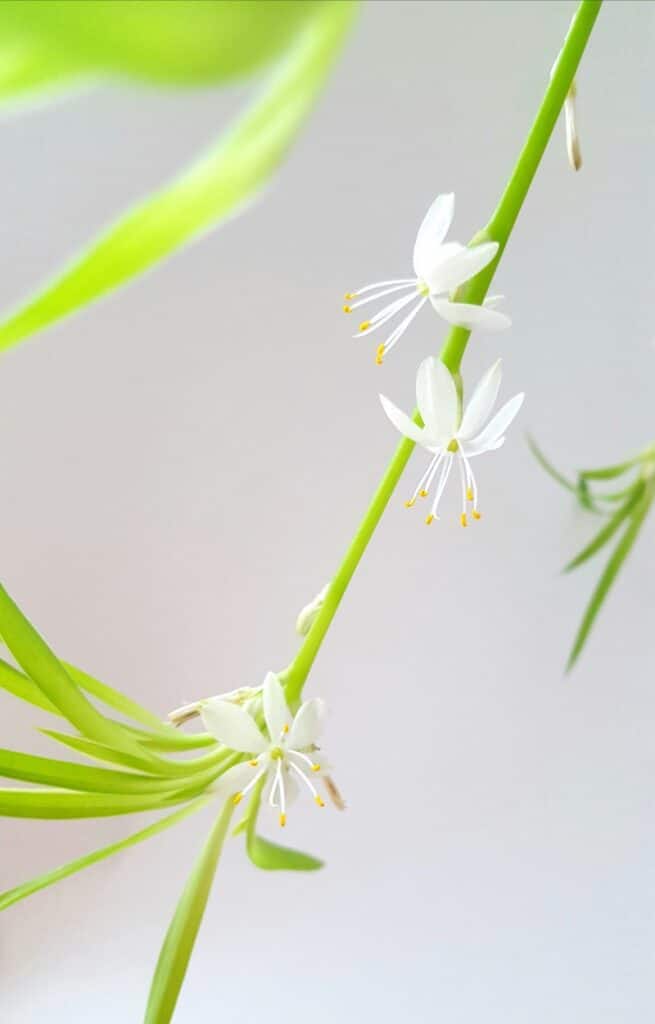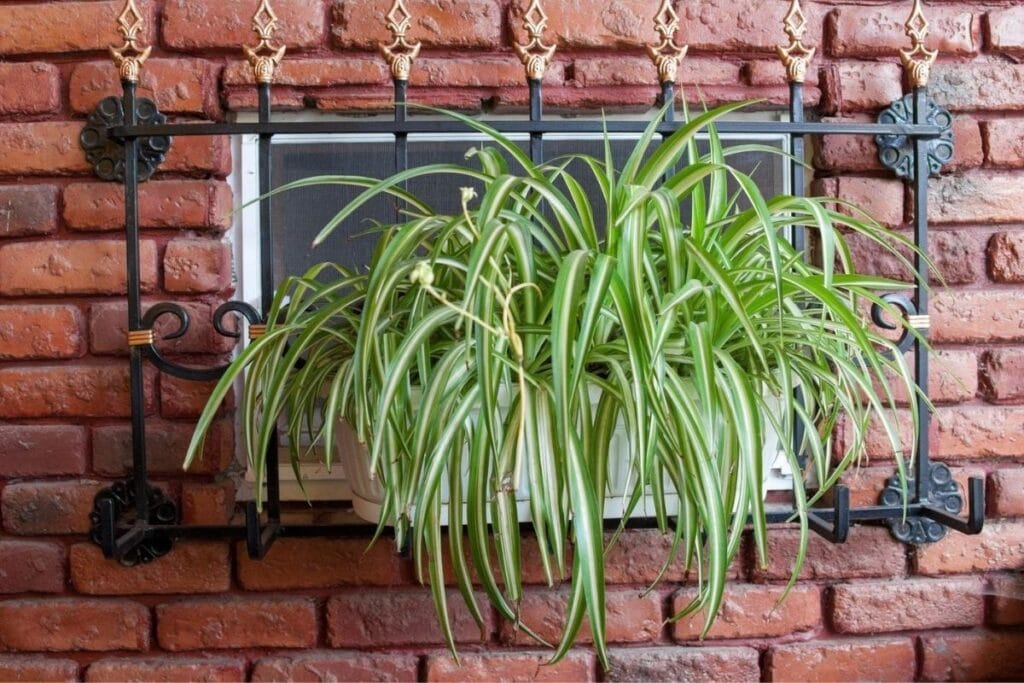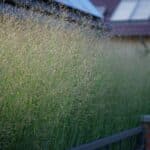Chlorophytum comosum is a plant species under the Asparagus family (Asparagaceae). They are commonly known as spider plants, but are otherwise called St. Bernard’s lily, airplane plants, ribbon plant, spider ivy, and hen-and-chickens.
Spider plants are native to South Africa but nowadays, they can be found in homes and gardens all around the world. Spider plants are named after the small plantlets that grow from the long stems of inflorescence drooping on the side of the mother plant, resembling a spider hanging from a web.
Spider plants are perennial flowering plants that can grow up to 24 inches tall. They are characterized by their long, thin leaves that droops downward towards the tip.
The leaves are arranged in a beautiful rosette, and are beautifully patterned with white, green, and yellow green. Uprooting the plant will reveal a collection of tuberous roots.
These plants bloom throughout the year. The inflorescence is borne in a long stem, about 30 inches in length, with small, greenish white florets (1).
What Are the Benefits of Having Spider Plants

Aside from their beautiful curving foliage that is sure to give personality to any space, spider plants are also found to have air-filtering properties. Just by having them as potted indoor plants, they can filter volatile substances such as formaldehyde, xylene, and toluene from our homes (2).
What Are Some Common Varieties of Spider Plants?
Spider plants have all-green and variegated forms. The popular ones are C. comosum ‘Vittatum’, C. comosum ‘Variegatum’ and C. comosum ‘Bonnie’.
‘Vittatum’
This variety features light green leaves with a broad creamy white stripe running along the center. They grow up to 2-ft tall with leaves reaching up to 18 inches in length. They are often found in garden centers as hanging plants, displaying the plantlets, but they also look perfect as bed and border plants (3).
‘Variegatum’
This variety features solid green leaves with narrow, white marginal stripes. It grows up to 7 inches tall and is more compact than ‘Vittatum’ (3).
‘Bonnie’
This variety is very similar to ‘Vittatum’ with light green leaves and creamy white center, except they are smaller, and their leaves are more curled. They are perfect hanging plants for small spaces.
Spider Plant Care Guide
Aside from their captivating fountain-like foliage and air-filtering capabilities, another reason why spider plants gained popularity as houseplants is its easy going nature. Spider plants are really easy to care for.
Here are some pointers on how to make the best out of your spider plants.
Light
Spider plants are not finicky when it comes to its light requirements. They will thrive in any light conditions ranging from semi-shade to full sunlight. The leaves of spider plants seem to be brighter in brighter atmospheres. When in sunny areas, avoid placing spider plants in direct sunlight to prevent leaf burn (4).
Additionally, if you want to propagate more spider plants, consider nurturing the baby spider plants that grow from the inflorescence. These little plantlets can be clipped off and easily propagated to expand your spider plant family!
Temperature and Humidity
Spider plants prefer average temperatures between 65-76oF (18-23oC) and average humidity. This is what makes them perfect indoor plants. Maintain average temperature and humidity and keep them from temperatures below 55oF (12oC) and above 80oF (26oC) (4).
Water
Spider plants should be watered regularly, especially during initial growth. Keep the soil moist during spring and summer. During fall and winter, the soil should be allowed to drain before the nest watering. Avoid overwatering, as this can cause root rot (4).
Soil and Fertilizer
Spider plants do not have any special soil requirements. As long as it is a well-draining soil, these plants can thrive. Spider plants will need fertilizer during the growing season. Feed them with half-strength balanced fertilizer at least twice every month during spring and summer (4).
See more: Best spider plant soil
Care and Propagation
The spider plant is a fast-growing plant because of this, they tend to become pot bound. Repotting should be done when the root tubers start to surface from the soil.
Propagating spider plants can be done through the spider plant babies or the plantlets that grow from the inflorescence. Pot the small plantlets once they develop roots or place them in a pot of soil next to the parent plant while still attached to allow them to root.
Alternatively, spider plants can be propagated by dividing mature plants during repotting.
Common Pests
Despite their hardy nature, spider plants are not unfamiliar to pests. Scale insects, aphids, and mealybugs are some of the common pests that can strike upon spider plants. Scales, aphids, and mealybugs can be easily dealt with by rinsing them with water.
In the case of spider mites, rinsing and application of miticide will be good to prevent brown leaf tips. If you notice any brown tips on your spider plant leaves, it’s essential to address the underlying issues promptly to maintain the plant’s health and appearance.
FAQs
How often should you water spider plants?
Spider plants should be watered thoroughly when the top inch of soil feels dry to the touch. Typically, this means watering approximately once a week, but frequency may vary depending on factors like humidity, temperature, and the plant’s environment.
Why is my spider plant crying?
When a spider plant appears to be “crying,” it’s usually due to overwatering. This can cause the tips of the leaves to turn brown and appear soggy or mushy. Adjusting the watering schedule and ensuring proper drainage can help prevent this issue.
What are the disadvantages of spider plants?
While spider plants are generally low-maintenance and beneficial for indoor air quality, they do have some disadvantages. They can be toxic to pets if ingested, although typically not severely harmful. Additionally, spider plants can be sensitive to fluoride and certain chemicals in tap water, which may cause leaf browning or other issues.
What does an overwatered spider plant look like?
An overwatered spider plant may exhibit symptoms such as yellowing or browning leaves, soft or mushy stems, and wilting despite being watered. The soil may also appear waterlogged, and roots may rot if the overwatering persists. Adjusting the watering frequency and ensuring proper drainage can help revive an overwatered spider plant.
References
Reference List
(1) Armstrong M. ’Wildlife and Plants. Volume 6’. Marshall Cavendish. 2007. PP 1020-1021.
(2) Dela Cruz M., Christensen J.J., Thomsen J.D., Muller R. ‘Can ornamental plants remove volatile organic compounds from indoor air? – a review.’ Environmental Science and Pollution Research. Springer-Verlag. 2014.
(3) Poole R.T., Chase A.R. Osborne L.S. ‘Spider Plant Production Guide’. Central Florida Research and Education Center. University of Florida IAFS. 1991.
(4) Murphy D.M. Duea A.W. “The Complete Guide to Growing Windowsill Plants: Everything You Need to Know Explained Simply”. Atlantic Publishing Company. 2011. PP 94-95.
Close
Photo by rootstocks/depositphotos







